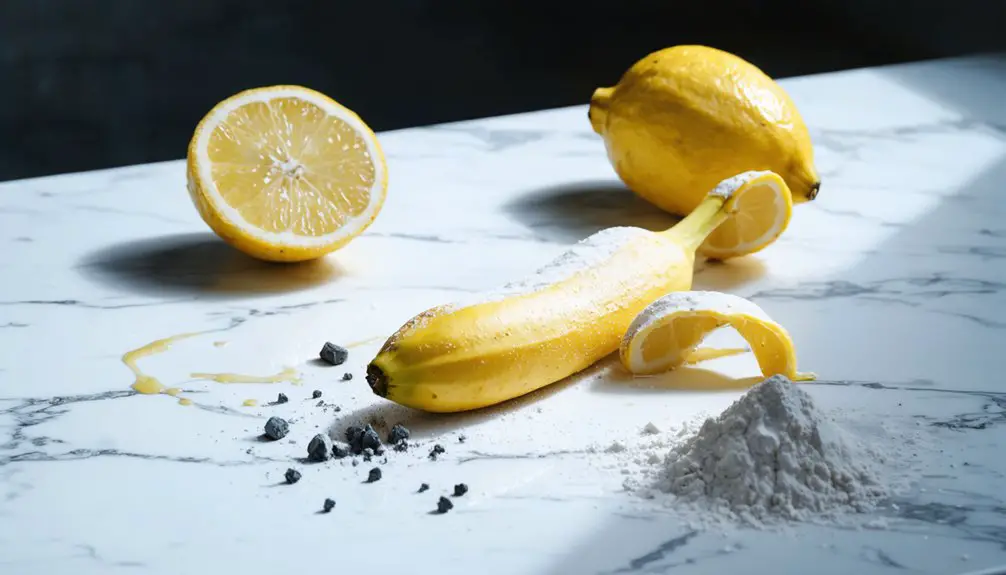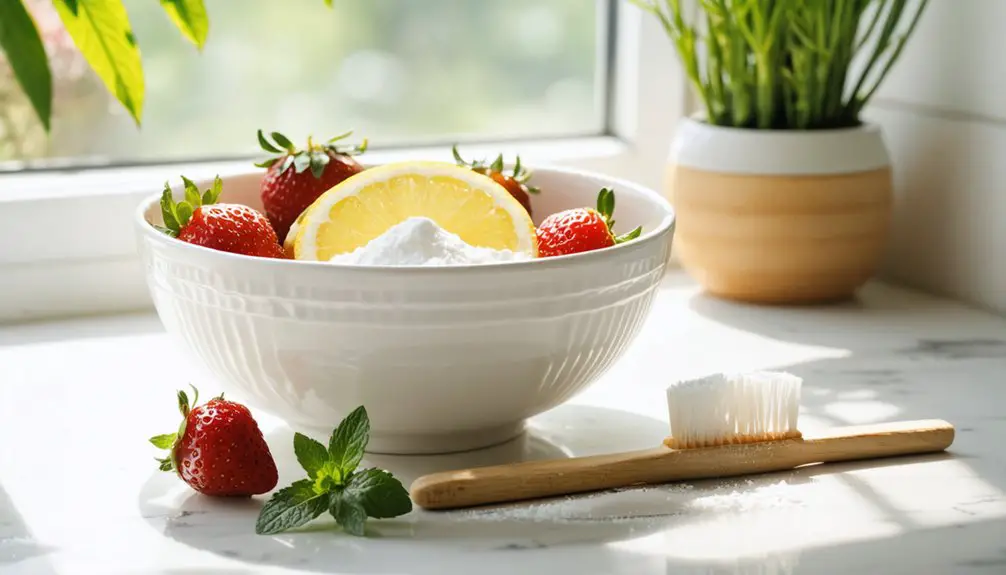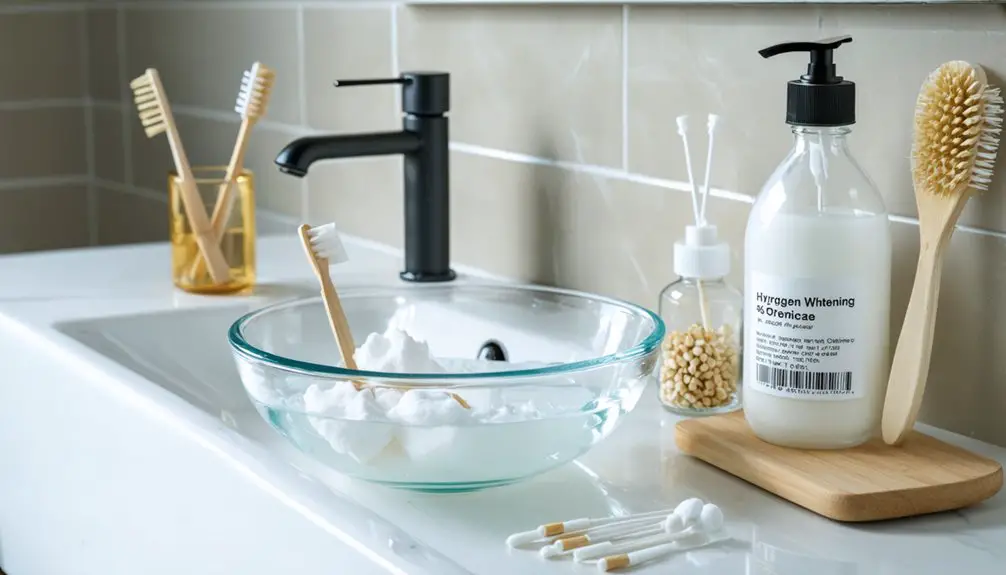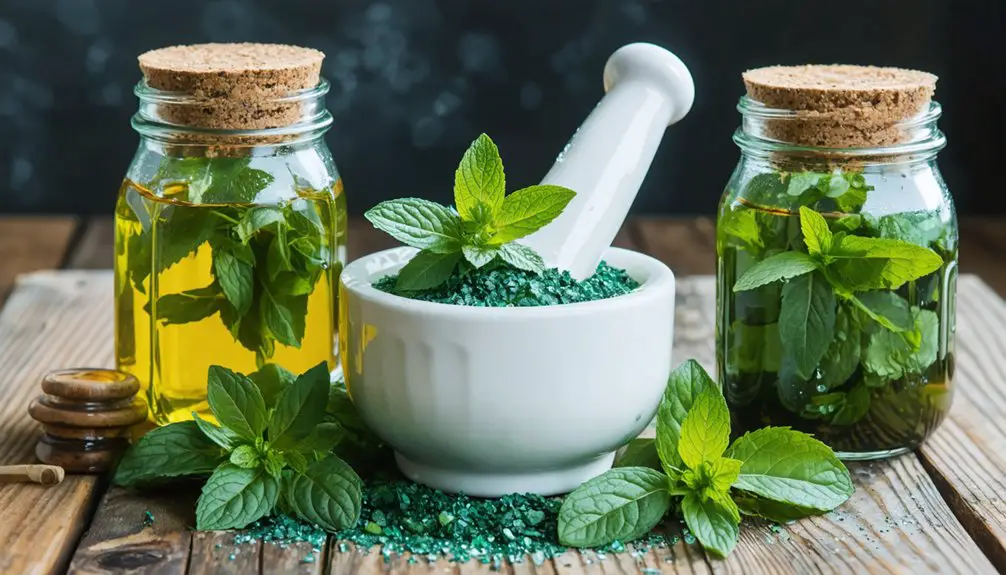Natural teeth whitening remedies work best because they use gentle oxidation reactions and enzymes to break down stains while protecting your enamel. You’ll get effective results from ingredients like baking soda, which removes surface stains through mild abrasion, and fruit enzymes that naturally brighten teeth. These methods maintain balanced oral chemistry and strengthen tooth structure, unlike harsh chemicals. Understanding the science behind these natural approaches will help you achieve ideal whitening results.
Key Takeaways
- Natural whitening agents work gradually through gentle oxidation reactions, preventing damage to tooth enamel while breaking down stains effectively.
- Enzymatic compounds like ficin and bromelain naturally alter tooth surface interactions with light without harsh chemical interference.
- Natural remedies maintain balanced oral chemistry while simultaneously strengthening tooth enamel through minerals and beneficial compounds.
- Home treatments like baking soda provide both stain removal and acid neutralization, creating an environment that prevents future discoloration.
- Natural whitening methods can safely complement professional treatments, offering sustainable long-term results through consistent, gentle maintenance.
The Science Behind Natural Whitening Methods
While many people seek natural alternatives to chemical teeth whitening, the effectiveness of these methods relies on specific molecular interactions within tooth structure.
Natural whitening agents work through oxidation reactions that break down stain molecules by penetrating your tooth’s porous enamel to reach deeper discoloration. Unlike traditional whitening methods that use high-concentration bleaching agents, natural alternatives typically provide more gradual results.
You’ll find two primary enzyme mechanisms at work in natural whitening. First, compounds like hydrogen peroxide generate free radicals that dismantle stain-causing molecular bonds. The process involves maintaining a proper pH balance to prevent enamel damage during whitening.
Second, specific enzymes such as ficin, bromelain, and papain act as gentle yet effective non-peroxide whitening agents. These natural enzymes promote safer whitening by preserving your enamel’s integrity while still achieving noticeable results.
The process alters how light interacts with your teeth, reducing stain molecule complexity and increasing light reflection for a whiter appearance.
Safe and Effective Home Remedies for Brighter Teeth
When using baking soda for teeth whitening, you’ll need to limit applications to once or twice weekly and mix it with enough water to form a loose paste that won’t scratch your enamel. The gentle abrasive nature of baking soda helps create an alkaline environment that inhibits bacterial growth.
While swishing with coconut oil can support your natural whitening efforts, remember this traditional practice works best as part of your overall oral care routine.
You can expect to see initial results from natural whitening methods within 2-4 weeks of consistent, proper use, though individual results will vary based on the type and severity of staining.
To protect your dental health while pursuing a brighter smile, you should maintain regular brushing habits between whitening treatments and stop immediately if you experience any sensitivity or discomfort.
Baking Soda Safety Tips
Although baking soda offers a cost-effective method for teeth whitening, its safe application requires careful attention to proper technique and frequency of use.
To prevent enamel erosion, you’ll need to mix the baking soda with enough water to create a smooth paste, avoiding any gritty texture that could harm your teeth.
Follow these baking soda precautions: brush gently with soft-bristled toothbrushes, limit applications to once every two weeks, and always rinse thoroughly afterward.
You’ll achieve the best results by using gentle, circular motions rather than aggressive scrubbing. Being an alkaline substance, baking soda helps neutralize acidic stains on teeth.
Remember that baking soda can’t replace your regular fluoride toothpaste, so use it as a supplementary treatment. While baking soda can effectively remove new surface stains, it may not work on deeper discoloration.
If you experience increased tooth sensitivity, discontinue use immediately and consult your dentist for professional guidance.
Natural Whitening Time Frames
Since natural teeth whitening methods work more gradually than professional treatments, understanding realistic time frames helps set proper expectations for results.
Natural remedy effectiveness varies considerably based on the method you choose and your teeth’s current condition.
You’ll typically see initial results from hydrogen peroxide-based treatments within 5-7 days, though you should limit use to once or twice weekly.
Coconut oil pulling requires 2-4 weeks of daily 15-20 minute sessions for visible improvement.
Activated charcoal shows moderate whitening after 1-2 weeks when used 2-3 times weekly.
While strawberry or lemon-based treatments may work within 1-2 weeks, their acidic nature demands cautious, limited application.
Crunchy fruits and vegetables can help naturally scrub away surface stains while you eat them.
Whitening duration variability depends largely on stain severity and your enamel characteristics, so patience and consistent application are essential for ideal results.
Daily use of these treatments, combined with good oral hygiene, ensures the best possible whitening outcomes while protecting your dental health.
Understanding How Baking Soda Brightens Your Smile
Your teeth can achieve a naturally whiter appearance through baking soda’s gentle yet effective abrasive action, which physically removes surface stains from coffee, tea, and wine without damaging your enamel.
When you brush with baking soda, its alkaline properties neutralize harmful acids in your mouth while creating an environment that’s less hospitable to stain-causing bacteria. For best results, brushing twice weekly with baking soda provides optimal whitening benefits without overuse.
These combined mechanical and chemical actions make baking soda an effective natural option for maintaining a brighter smile while protecting your oral health. Creating a paste with equal parts water and baking soda provides an easy, affordable home remedy for teeth whitening.
Gentle Surface Stain Removal
When surface stains from coffee, tea, wine, and tobacco accumulate on tooth enamel, baking soda‘s mild abrasive properties can effectively polish them away. Through gentle abrasion, you’ll notice visible whitening effects within days to weeks of consistent use, as the highly soluble particles work to mechanically lift extrinsic stains without damaging your teeth’s protective layer.
For ideal enamel protection, you’ll want to create a paste by mixing baking soda with water and apply it using a soft-bristled toothbrush in circular motions for about two minutes.
While it’s less potent than professional whitening treatments, clinical studies confirm that this natural approach delivers significant color improvements.
Remember to maintain gentle pressure during application, as excessive force isn’t necessary and could compromise your enamel’s integrity.
Ph Balance Benefits
The alkaline properties of baking soda create a powerful pH-balancing effect in your mouth, directly counteracting harmful acids produced by bacteria.
Through consistent pH regulation, you’ll protect your teeth from the destructive effects of acid erosion while creating an environment where staining bacteria can’t thrive.
For ideal enamel preservation, focus on these key pH-balancing benefits:
- Neutralizes acidic compounds that weaken tooth structure
- Prevents demineralization by maintaining balanced oral chemistry
- Reduces bacterial growth that leads to staining and discoloration
Dietary Changes That Support Natural Teeth Whitening
Making strategic dietary changes can considerably enhance your teeth’s natural whitening process through both enzymatic and mechanical actions.
You’ll benefit from fruit enzymes like malic acid in strawberries and bromelain in pineapples, which chemically break down surface stains without damaging enamel. Incorporate crunchy vegetables like carrots, celery, and broccoli to naturally scrub your teeth while stimulating saliva production.
Strengthen your enamel by consuming dairy products rich in calcium and lactic acid.
You’ll want to drink plenty of water, especially after consuming staining beverages, as it helps flush away pigments and food debris. Consider using a straw when drinking coffee or tea to minimize contact with your teeth.
Replace stain-causing foods with natural cleansers to maintain whiter teeth long-term.
Common Mistakes to Avoid With Natural Whitening

Many people undermine their teeth whitening efforts by making significant mistakes that can lead to permanent damage. One of the most common misconceptions involves using natural ingredients without proper preparation or consultation. Before trying natural whitening methods, you’ll need professional guidance to guarantee they’re suitable for your teeth.
To maximize natural ingredient effectiveness, avoid these vital mistakes:
- Skipping thorough teeth cleaning before applying natural whiteners, which reduces their contact with enamel.
- Using excessive amounts of whitening ingredients, thinking more will yield faster results.
- Failing to maintain consistent oral hygiene during the whitening process.
Don’t compromise your dental health by ignoring professional advice or having unrealistic expectations.
Natural whitening requires patience and proper technique to achieve safe, lasting results without damaging your enamel or gums.
Combining Natural Methods With Professional Care
Successfully optimizing tooth whitening outcomes involves combining natural remedies with professional dental care in a strategic, evidence-based approach.
Through professional synergy, you’ll achieve faster, more visible results while protecting your enamel integrity. Professional treatments with hydrogen peroxide provide rapid whitening effects, while natural methods offer gentle maintenance support.
Combining professional whitening treatments with natural maintenance methods delivers optimal results while safeguarding your teeth’s protective enamel layer.
For natural enhancement of professional results, you’ll want to incorporate carefully selected remedies like baking soda brushing and oil pulling after your dental treatments.
This combination helps maintain your whiter shade while reducing sensitivity risks. Your dentist can assess your specific needs and create a personalized plan that integrates both approaches effectively.
Maintaining Long-Term Results Naturally

To maintain long-term whitening results naturally, you’ll need to implement a consistent care routine that addresses both prevention and maintenance.
Focus on lifestyle modifications that minimize exposure to staining agents while protecting your enamel through proper oral hygiene practices.
For ideal long-term results, follow these essential steps:
- Apply whitening agents consistently over 2-6 weeks, then maintain with periodic treatments every 6-12 months.
- Alternate between whitening and enamel-strengthening products to preserve tooth integrity.
- Reduce consumption of staining substances like coffee, tea, and red wine.
Your commitment to enamel protection will greatly impact the longevity of your results.
Regular brushing and flossing help prevent stain reabsorption, while avoiding acidic substances preserves the tooth surface structure necessary for maintaining whiteness.
Frequently Asked Questions
How Long Should I Wait Between Different Natural Whitening Treatments?
After 72 hours, 90% of enamel remineralizes. You’ll need to wait 3-7 days between natural whitening applications, adjusting treatment combinations based on your tooth sensitivity and enamel strength.
Can Natural Whitening Methods Remove Deep Stains From Antibiotics or Fluorosis?
No, you can’t effectively remove deep stains from antibiotics or fluorosis using natural methods. These intrinsic stains require professional treatments like carbamide peroxide gels for meaningful whitening effectiveness.
Are Natural Whitening Methods Safe During Pregnancy and Breastfeeding?
Prudent parents prefer natural whitening methods during pregnancy and breastfeeding. You’ll find safe ingredients like baking soda and strawberries preferable, but always follow pregnancy precautions and consult your healthcare provider first.
Do Natural Whitening Remedies Work Differently on Crowns and Veneers?
Your natural whitening remedies won’t effectively whiten crowns or veneers due to their durability and non-porous materials. While they may remove surface stains, you’ll need professional treatment for significant color changes.
How Do Genetics and Age Affect the Success of Natural Teeth Whitening?
Your genetic predisposition affects enamel thickness and staining susceptibility, while age-related changes thin your enamel and darken dentin, greatly impacting how well natural whitening methods work for you.
References
- https://pmc.ncbi.nlm.nih.gov/articles/PMC10024105/
- https://www.frontiersin.org/journals/dental-medicine/articles/10.3389/fdmed.2021.687507/full
- https://www.luriedental.com/dental-services/cosmetic/blog/do-natural-teeth-whitening-remedies-really-work
- https://www.dentistryformidtown.com/blog/natural-teeth-whitening-remedies-separating-fact-from-fiction/
- https://health.clevelandclinic.org/is-teeth-whitening-safe
- https://cosmeticdentistryofsa.com/the-science-behind-teeth-whitening/
- https://sandlakedental.com/blog/understanding-the-science-behind-teeth-whitening/
- https://www.nature.com/articles/s41598-020-66733-z
- https://pmc.ncbi.nlm.nih.gov/articles/PMC4058574/
- https://www.lwdentist.com/diy-teeth-whitening-what-works-and-what-to-avoid/



